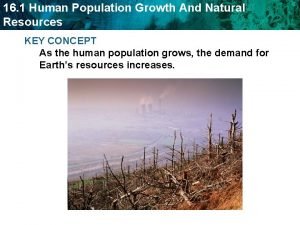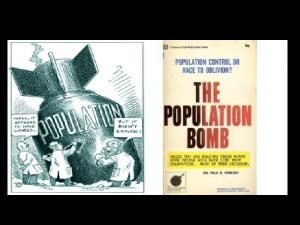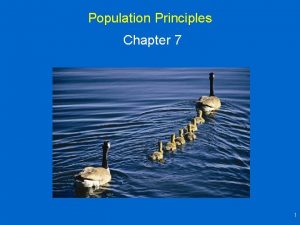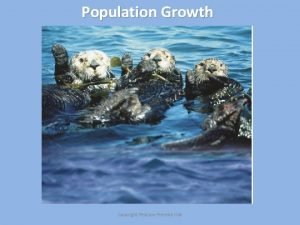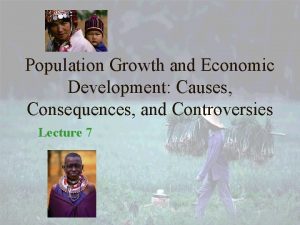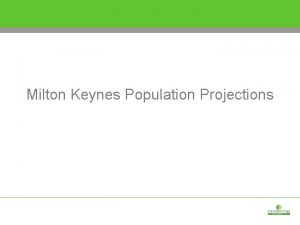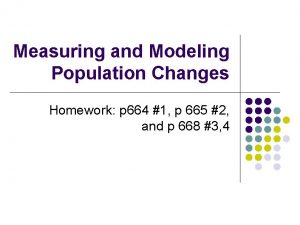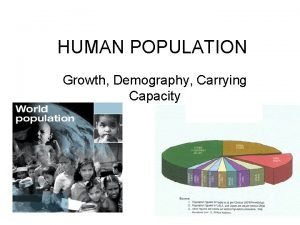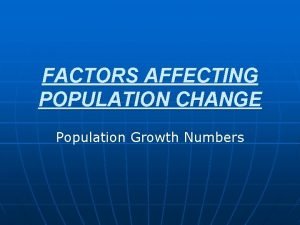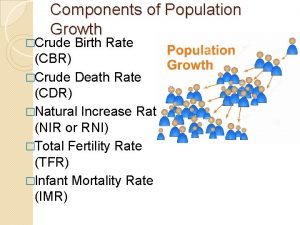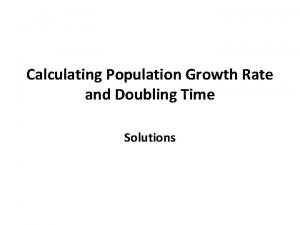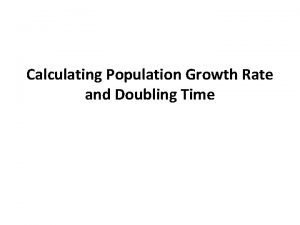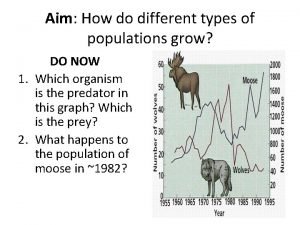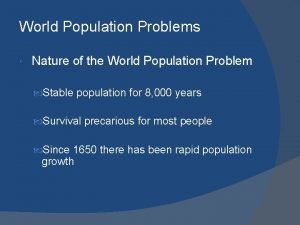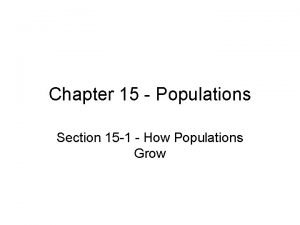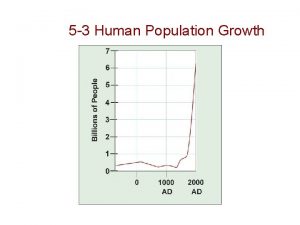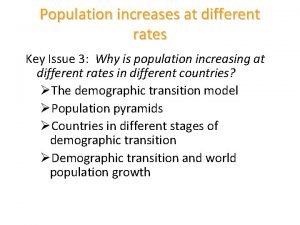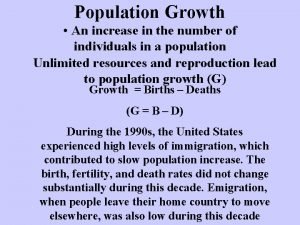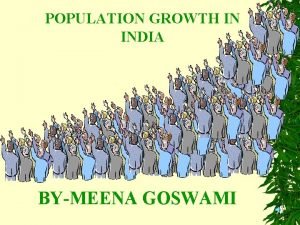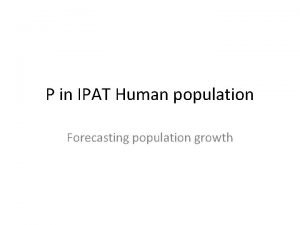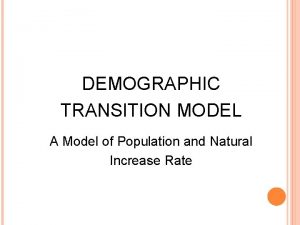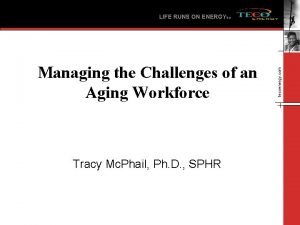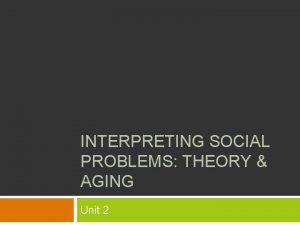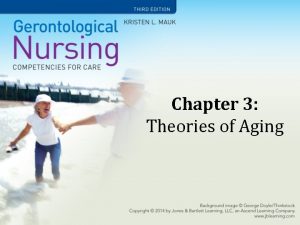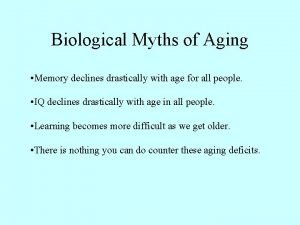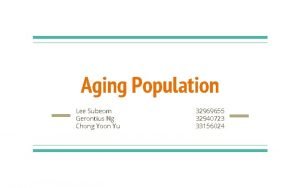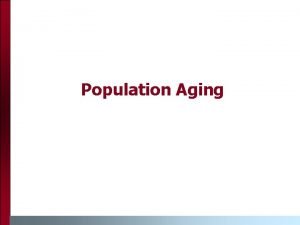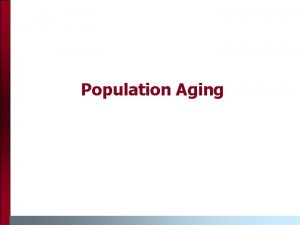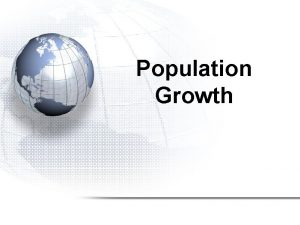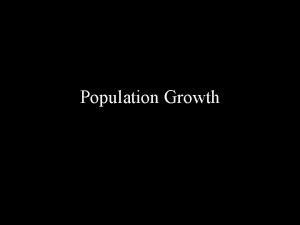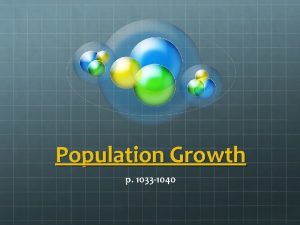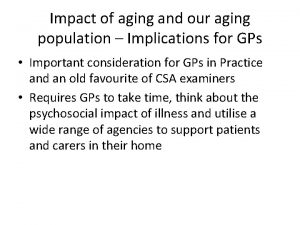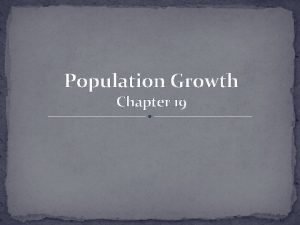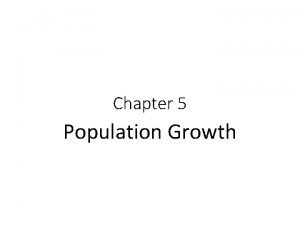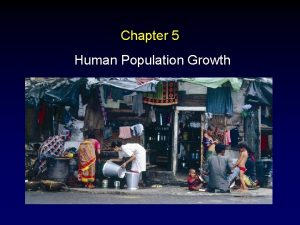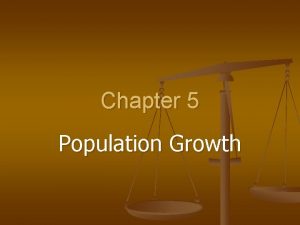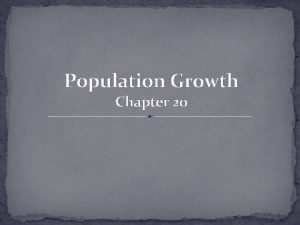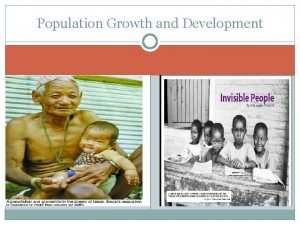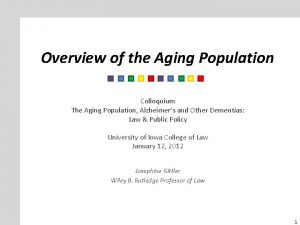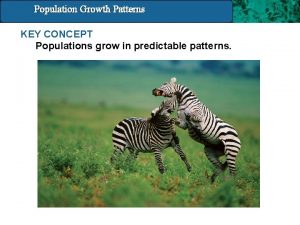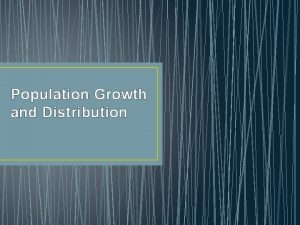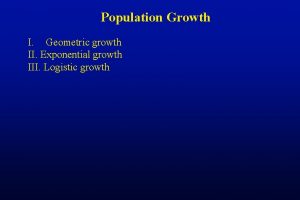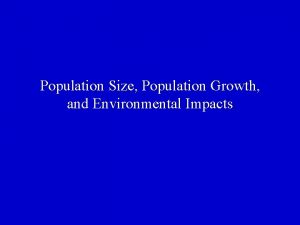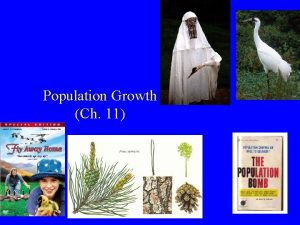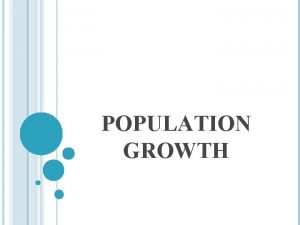Chapter 12 Population Growth and Aging Population may


































































- Slides: 66

Chapter 12: Population Growth and Aging “Population may be the key to all the issues that will shape the future: economic growth; environmental security; and the health and well-being of countries, communities, and families. ” —Nafis Sadik, former executive director, United Nations Population Fund

Chapter Outline • The Global Context: A World View of Population Growth and Aging • Sociological Theories of Population Growth and Aging • Social Problems Related to Population Growth and Aging • Strategies for Action: Responding to Problems of Population Growth and Aging • Understanding Problems of Population Growth and Aging

The Global Context: A World View of Population Growth and Aging • World population was 1. 6 billion when we entered the 20 th century, and 6. 1 billion when we entered the 21 st century. • In only 12 years, world population grew from 6 billion (in 1999) to 7 billion (in 2011).

The Global Context: A World View of Population Growth and Aging • World Population: History, Current Trends, and Future Projections – For 99% of human history population growth was restricted by disease and food supplies. – This continued until the mid-18 th century, when the Industrial Revolution improved the standard of living for much of the world. • Improvements included better food, cleaner drinking water, improved housing and sanitation, and medical advances.

The Global Context: A World View of Population Growth and Aging • World Population: History, Current Trends, and Future Projections – For 99% of human history population growth was restricted by disease and food supplies. – This continued until the mid-18 th century, when the Industrial Revolution improved the standard of living for much of the world. • Improvements included better food, cleaner drinking water, improved housing and sanitation, and medical advances.

The Global Context: A World View of Population Growth and Aging

The Global Context: A World View of Population Growth and Aging • Doubling Time: The time it takes for a population to double in size from any base year. • Doubling times: – Several thousand years for the world population to grow from 4 to 8 million – A few thousand years to grow from 8 to 16 million

The Global Context: A World View of Population Growth and Aging • Doubling Time Continued: – About 1, 000 years to grow from 16 to 32 million – Less than 1, 000 years to grow to 64 million. – The recent doubling, from 3 billion in 1960 to 6 billion in 1999, took about 40 years. – It will probably not double in size again.

The Global Context: A World View of Population Growth and Aging

The Global Context: A World View of Population Growth and Aging

The Global Context: A World View of Population Growth and Aging • Nearly all of world population growth is in less developed countries, mostly in Africa and Asia. • Higher population growth in developing countries is largely due to higher total fertility rates - the average lifetime number of births per woman in a population. • Although total fertility rates worldwide have declined significantly from nearly 5 in the 1950 s to 2. 45 between 2010 and 2015, they continue to be highest in the least developed countries of the world.

The Global Context: A World View of Population Growth and Aging

The Global Context: A World View of Population Growth and Aging

The Global Context: A World View of Population Growth and Aging

The Global Context: A World View of Population Growth and Aging • To reach population stabilization, fertility rates throughout the world would need to achieve what is called “replacement level, ” whereby births would replace, but not outnumber, deaths. • Replacement-level fertility is 2. 1 births per woman, that is, slightly more than 2 because not all female children will live long enough to reach their reproductive years. • In some of these countries, population will continue to grow for several decades because of population momentum, or continued population growth as a result of past high fertility rates that have resulted in a large number of young women who are currently entering their childbearing years.

The Global Context: A World View of Population Growth and Aging The Aging of the World’s Population • Another demographic trend that presents its own set of challenges is the increasing number and proportion of older individuals in the total population. • Between 2010 and 2050, the percentage of older individuals (ages 65 and over) in the world population is expected to double, and will nearly double in the United States

The Global Context: A World View of Population Growth and Aging The Aging of the World’s Population • The aging of the world’s population is due to both declining levels of fertility and to increased longevity. • In more than 70 countries—including China, Japan, and all European countries—fertility rates have fallen well below the 2. 1 children replacement level (United Nations 2011). • Globally, life expectancy increased from 49 in the 1950 s to 68 between 2005 and 2010, and is expected to rise to 81 between 2095 and 2100.

The Global Context: A World View of Population Growth and Aging The Aging of the World’s Population

The Global Context: A World View of Population Growth and Aging The Aging of the World’s Population • An unusually large generation of Americans known as the baby boomers, or the generation of Americans born between 1946 and 1964, a period of high birthrates • Population aging increases pressure on a society’s ability to support its elderly members. • A commonly used indicator of this pressure is the elderly support ratio, calculated as the number of working-age people divided by the number of people 65 or older.

Sociological Theories of Population Growth and Aging Structural-Functionalist Theory • Structural functionalism focuses on how changes in one aspect of the social system affect other aspects of society. • For example, the demographic transition theory of population describes how industrialization has affected population growth.

Sociological Theories of Population Growth and Aging Structural-Functionalist Theory • The structural-functionalist perspective also focuses attention on the unintended, or latent, consequences of social behavior. • Although the intended, or manifest, function of modern contraception is to control and limit childbearing, there have also been far-reaching unintended effects of contraception on the social and economic status of women. • The development of modern contraceptives—particularly the birth control pill—has led to fewer births to high school- and college-aged women, increased age at first marriage, and increased participation by women in the workforce.

Sociological Theories of Population Growth and Aging Conflict Theory • The conflict perspective focuses on how wealth and power, or the lack thereof, affect population problems. • Conflict theorists also note that population growth results from pervasive poverty and the subordinate position of women in many less developed countries. • Some conflict theorists view the elderly population as a special interest group that competes with younger populations for scarce resources.

Sociological Theories of Population Growth and Aging Symbolic Interactionist Theory • The symbolic interactionist perspective focuses on how meanings, labels, and definitions learned through interaction affect population problems. For example, many societies are characterized by pronatalist, or a cultural value that promotes having children. • The symbolic interactionist perspective also emphasizes the importance of examining social meanings and definitions associated with aging. – “Old age” is largely a social construct; there is no biological marker that indicates when a person is “old. ”

What Do You Think?

Social Problems Related to Population Growth and Aging Environmental Problems and Resource Scarcity • Research suggests that overpopulation is the world’s top environmental problem, followed closely by climate change and the need to replace fossil fuels with renewable energy sources. • According to the United Nations Environment Programme (UNEP), half of the planet’s forests have been cleared for human land use and, in 2025, two-thirds of the world’s population will be living in countries with water scarcity or stress, and the world’s fisheries will be depleted by the middle of this century.

Social Problems Related to Population Growth and Aging Environmental Problems and Resource Scarcity • However, countries with the largest populations do not necessarily have the largest impact on the environment. • This is because the demands that humanity makes on the earth’s natural resources—each person’s environmental footprint is determined by the patterns of production and consumption in that person’s culture.

What Do You Think?

Social Problems Related to Population Growth and Aging Poverty, Unemployment, and Global Insecurity • Poverty and unemployment are problems that plague countries with high population growth. • Less developed, poor countries with high birthrates do not have enough jobs for a rapidly growing population, and land for subsistence farming becomes increasingly scarce as populations grow. • In some ways, poverty leads to high fertility, because poor women are less likely to have access to contraception and are more likely to have large families in the hope that some children will survive to adulthood and support them in old age.

Social Problems Related to Population Growth and Aging Poor Maternal, Infant, and Child Health • Maternal deaths (deaths related to pregnancy and childbirth) are the leading cause of mortality for reproductive-age women in the developing world. • Having several children at short intervals increases the chances of premature birth, infectious disease, and death for the mother or the baby. • Childbearing at young ages (teens) also increases the risks of health problems and death for both women and infants.

Social Problems Related to Population Growth and Aging Ageism: Prejudice and Discrimination toward the Elderly • Ageism refers to negative stereotyping, prejudice, and discrimination based on a person’s or group’s perceived chronological age. • Ageism is reflected in negative stereotypes of the elderly. • Another form of ageism, ageism by invisibility, occurs when older adults are not included in advertising and educational materials.

Social Problems Related to Population Growth and Aging Ageism: Prejudice and Discrimination toward the Elderly • Ageism refers to negative stereotyping, prejudice, and discrimination based on a person’s or group’s perceived chronological age. • Ageism is reflected in negative stereotypes of the elderly. • Another form of ageism, ageism by invisibility, occurs when older adults are not included in advertising and educational materials.

Social Problems Related to Population Growth and Aging Ageism: Prejudice and Discrimination toward the Elderly

Social Problems Related to Population Growth and Aging Ageism: Prejudice and Discrimination toward the Elderly

What Do You Think?

Social Problems Related to Population Growth and Aging Ageism: Prejudice and Discrimination toward the Elderly • Another indicator of ageism in our society is the negative view of wrinkles, gray hair, and other physical signs of aging. • Millions of Americans purchase products or treatments to make them look younger, spending substantial sums of money and undergoing unnecessary and often risky medical procedures to look younger.

Social Problems Related to Population Growth and Aging Ageism: Prejudice and Discrimination toward the Elderly

Social Problems Related to Population Growth and Aging Ageism: Prejudice and Discrimination toward the Elderly • Employment Age Discrimination – Most (80 percent of) Americans think they will continue working full or part-time after they reach retirement age, either because they will want to (44 percent) or because they will have to (36 percent). – Lahey (2008) found that younger job seekers were 40 percent more likely to be offered a job interview than older job seekers with similar resumes. – Older workers may be more vulnerable to being “let go” because, although they have seniority on the job, they may also have higher salaries.

Social Problems Related to Population Growth and Aging Family Caregiving for Our Elders • Adults who care for their aging parents while also taking are of their own children are referred to as members of the sandwich generation. • For thousands of years, caring for older adults has been an important function of the family. • Due to social, economic, and cultural changes, it has become more difficult for families throughout the world to care for aging parents. • Millions of Chinese families have signed a Family Support Agreement; a voluntary contract between older parents and adult children that specifies the details of how the adult children will provide parental care.

What Do You Think?

Social Problems Related to Population Growth and Aging Retirement Concerns of Older Americans and the Role of Social Security • One of the concerns as we age is financial planning for retirement. • A majority (53 percent) of non-retired U. S. adults do not think they will have enough money to live comfortably in retirement, up from about a third in 2002 (Newport 2011). • These concerns are not unfounded: The Center for Retirement Research estimates that more than half of U. S. households are at high risk of experiencing a significant drop in living standards at retirement.

Social Problems Related to Population Growth and Aging Retirement Concerns of Older Americans and the Role of Social Security

Social Problems Related to Population Growth and Aging Retirement Concerns of Older Americans and the Role of Social Security • Types of Retirement Plans Retirement plans include: – (1) traditional pensions, which are “defined benefit” plans, in which retirees receive a specified annual amount until their death; and – (2) “defined contribution” plans in which workers contribute money to 401 k plans or individual retirement accounts (IRAs), without any guarantee of what their future benefits will be.

Social Problems Related to Population Growth and Aging Retirement Concerns of Older Americans and the Role of Social Security • The Role of Social Security in Retirement: In addition to retirement plans and savings, most workers are eligible to receive Social Security retirement benefits when they reach retirement age. • Social Security, actually titled “Old Age, Survivors, Disability, and Health Insurance, ” is a federal insurance program established in 1935 that protects against loss of income due to retirement, disability, or death. • More than two-thirds (69 percent) of Social Security benefits paid in 2009 were retirement benefits, 19 percent were disability benefits, and 12 percent were survivor benefit

Social Problems Related to Population Growth and Aging Retirement Concerns of Older Americans and the Role of Social Security

Social Problems Related to Population Growth and Aging Retirement Concerns of Older Americans and the Role of Social Security • How Is Social Security Funded? : Social Security is funded by workers through a payroll tax called the Federal Insurance Contributions Act (FICA) that comprises 12. 4 percent of a worker’s wages. Another source of funding for Social Security is a tax on higher-income beneficiaries. • Is Social Security in Crisis? : In 2010, Social Security’s income ($781 billion) exceeded its expenditures ($713 billion). – Potential Problems: obligations to future retirees, including the retirement of the baby boomers, increasing longevity, the declining elderly support ratio (fewer workers per beneficiary), widening wage inequality (which means that more income is not subject to Social Security taxes), high rates of unemployment, and wage stagnation.

Strategies for Action: Responding to Problems of Population Growth and Population Aging Efforts to Curb Population Growth: Reducing Fertility • To some population experts, stopping population growth is a critical issue. • Although worldwide fertility rates have fallen significantly since the 1950 s, they are still high in many less developed regions.

Strategies for Action: Responding to Problems of Population Growth and Population Aging Efforts to Curb Population Growth: Reducing Fertility

What Do You Think?

Strategies for Action: Responding to Problems of Population Growth and Population Aging Efforts to Curb Population Growth: Reducing Fertility • Family Planning and Contraception – Worldwide, a slight majority (55 percent) of married women ages 15 to 49 uses some form of modern contraception; in the United States, 73 percent of women use modern contraception. – However, in least developed countries, fewer than one in four (23 percent) married women use modern contraception.

Strategies for Action: Responding to Problems of Population Growth and Population Aging Efforts to Curb Population Growth: Reducing Fertility

Strategies for Action: Responding to Problems of Population Growth and Population Aging Efforts to Curb Population Growth: Reducing Fertility • Other reasons for not using modern contraception include: – (1) the belief that modern methods of contraception are dangerous; – (2) male partners are opposed to using modern contraception; – (3) the belief that one’s religion opposes the use of contraception; and – (4) the belief that God should decide how many children a woman has.

Strategies for Action: Responding to Problems of Population Growth and Population Aging Efforts to Curb Population Growth: Reducing Fertility • The Status of Women: The Importance of Education and Employment – Educated women are more likely to marry later, want smaller families, and use contraception. – Better-educated women tend to delay marriage and exercise more control over their reproductive lives, including decisions about childbearing. – Another important component of family planning and reproductive health programs involves changing traditional male attitudes toward women.

Strategies for Action: Responding to Problems of Population Growth and Population Aging Efforts to Curb Population Growth: Reducing Fertility • Access to Safe Abortion – Abortion is a sensitive and controversial issue that has religious, moral, cultural, legal, political, and health implications. – Worldwide, one in five pregnancies ends in abortion, and one in ten pregnancies ends in unsafe abortion, including those performed in unhygienic conditions by unskilled providers (such as traditional or religious healers and herbalists) and those that are self-induced by a woman inserting a foreign object into her uterus, ingesting toxic substances, or inflicting trauma to the abdomen. – Of the estimated 42 million abortions each year, about 47, 000 girls and women die. Almost all unsafe abortions take place in developing countries.

Strategies for Action: Responding to Problems of Population Growth and Population Aging Efforts to Curb Population Growth: Reducing Fertility • China’s One-Child Policy: – In 1979, China initiated a national family planning policy that encourages families to have only one child by imposing a monetary fine on couples that have more than one child. – The implementation and enforcement of this policy varies from one province to another, and there a number of exemptions that allow some couples to have two or even more children. – Nevertheless, the one-child policy has been effective in reducing population growth in China, which has the highest rate of modern contraceptive use in the world. – Of married women ages 15 to 49 in China, 86 percent use moder contraceptives.

Strategies for Action: Responding to Problems of Population Growth and Population Aging Efforts to Curb Population Growth: Reducing Fertility • Voluntary Childlessness: In the United States, as in other countries of the world, the cultural norm is for women and couples to, sooner or later, want to have children. • However, a small but growing segment of U. S. women and men do not want children and choose to be childfree. • In the United States, 7 percent of women ages 35 to 44 are voluntarily childless, making voluntary childlessness more common than involuntary childlessness (Hollander 2007). • In general, childfree couples are more educated, live in urban areas, are less religious, and do not adhere to traditional gender ideology

Strategies for Action: Responding to Problems of Population Growth and Population Aging Combating Ageism and Age Discrimination in the Workplace • One strategy to combat ageism involves incorporating positive views of aging in educational lessons, beginning in preschool, and in other forms of media. • In 1967, Congress passed the Age Discrimination in Employment Act (ADEA), which was designed to ensure continued employment for people between the ages of 40 and 65.

Strategies for Action: Responding to Problems of Population Growth and Population Aging Options for Reforming Social Security • Cut Social Security Benefits – Some reform proposals call for cuts in Social Security benefits, which would create a significant financial burden on households that depend on Social Security. • Increase Social Security Revenue – Instead of cutting benefits, many advocates for the elderly suggest raising revenues. Expand Social Security Benefits In this current economic climate, people need more, not less, economic support.

Understanding Problems of Population Growth and Aging • First, although fertility rates have declined significantly in recent years and although many countries are experiencing a decline in their fertility rates, world population will continue to grow for several decades. • As fertility rates decline and life expectancy increases, the United States and other countries are experiencing population aging. • Although older individuals struggle against ageism, families and governments face challenges of meeting the needs of seniors.

Quick Quiz 1. Why do rural dwellers migrate to urban areas? A. B. C. D. flee from war to find employment flee from natural disasters all of these choices

Answer: D • Rural dwellers migrate to urban areas to flee from war, to find employment and flee from natural disasters.

Quick Quiz 2. According to structural-functionalists, what does the expansion of urban areas lead to? A. B. C. D. increased rates of poverty increased rates of inequality increased rates of anomie increased rates of labeling

Answer C • According to structural-functionalists, the expansion of urban areas leads increased rates of anomie.

Quick Quiz 3. John lost his job when the factory where he worked moved out of state. Urban unemployment and poverty are partly the result of what happened to John. This is an example of what? A. B. C. D. gentrification deindustrialization reindustrialization deconcentration

Answer: B • John lost his job when the factory where he worked moved out of state. Urban unemployment and poverty are partly the result of what happened to John. This is an example deindustrialization.

Quick Quiz 4. Demographic transition theory refers to: A. the idea that as urbanization progresses fertility rates will inevitably decline. B. the idea that as urbanization progresses fertility rates will rise necessitating governmental population control. C. the idea that as agricultural societies transform into industrial ones there will be accompanying rises to fertility. D. none of these choices.

Answer: A • Demographic transition theory refers to the idea that as urbanization progresses fertility rates will inevitably decline.
 Growth analysis definition
Growth analysis definition Monocots vs eudicots
Monocots vs eudicots Primary growth and secondary growth in plants
Primary growth and secondary growth in plants Primary growth and secondary growth in plants
Primary growth and secondary growth in plants Section 1 population dynamics answer key
Section 1 population dynamics answer key Study guide chapter 4 section 1 population dynamics
Study guide chapter 4 section 1 population dynamics Chapter 10 geriatric care
Chapter 10 geriatric care Natural resources and population growth
Natural resources and population growth Growth and decay equation
Growth and decay equation Step growth polymerization vs chain growth
Step growth polymerization vs chain growth Geometric exponential growth
Geometric exponential growth Neoclassical growth theory vs. endogenous growth theory
Neoclassical growth theory vs. endogenous growth theory Difference between organic and inorganic growth
Difference between organic and inorganic growth Rule of 70 in population growth
Rule of 70 in population growth What are the two types of population growth
What are the two types of population growth Modeling population growth rabbits answer key
Modeling population growth rabbits answer key Population growth curve
Population growth curve Copyright
Copyright Why population growth is good
Why population growth is good What is population ecology
What is population ecology Logistic and exponential growth
Logistic and exponential growth Population milton keynes
Population milton keynes Biotic potential
Biotic potential Rule of 70 in population growth
Rule of 70 in population growth Age structure diagram slow growth
Age structure diagram slow growth Population growth factors
Population growth factors Linear differential equation
Linear differential equation Fertility rate decline
Fertility rate decline Unalaska population pyramid
Unalaska population pyramid K selection r selection
K selection r selection How to calculate population growth rate
How to calculate population growth rate Cbr-cdr/10
Cbr-cdr/10 Density-dependent limiting factors definition apes
Density-dependent limiting factors definition apes Rule of 70 in population growth
Rule of 70 in population growth What are the two types of population growth
What are the two types of population growth Importance of population growth
Importance of population growth World population by age
World population by age Arithmetically vs geometrically growth
Arithmetically vs geometrically growth Yeast population growth lab
Yeast population growth lab Whats a density dependent limiting factor
Whats a density dependent limiting factor Exponential growth curve of a hypothetical population
Exponential growth curve of a hypothetical population 5-3 human population growth
5-3 human population growth Key issue 3 why does population growth vary among regions
Key issue 3 why does population growth vary among regions Population growth means
Population growth means Short essay on population growth
Short essay on population growth Percent change
Percent change Why does population growth vary among regions
Why does population growth vary among regions Market forms of meat processed meat
Market forms of meat processed meat Jessie emily schofield lyrics
Jessie emily schofield lyrics Disability resource center uky
Disability resource center uky Dane county aging and disability resource center
Dane county aging and disability resource center Memory aging and brain maintenance
Memory aging and brain maintenance Managing the aging workforce challenges and solutions
Managing the aging workforce challenges and solutions Office of aging
Office of aging Oaas as a service
Oaas as a service Population ecology section 1 population dynamics answer key
Population ecology section 1 population dynamics answer key Population ecology section 1 population dynamics
Population ecology section 1 population dynamics Hci design patterns
Hci design patterns Human needs theory of aging
Human needs theory of aging Philosophy for old age (absolutely brilliant)
Philosophy for old age (absolutely brilliant) Symbolic interaction theory of aging
Symbolic interaction theory of aging Aging algorithm page replacement
Aging algorithm page replacement Non stochastic theory of aging
Non stochastic theory of aging Conclusion of aging
Conclusion of aging Dr berg how to look younger
Dr berg how to look younger Alaska commission on aging
Alaska commission on aging Conclusion of aging
Conclusion of aging







